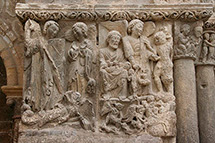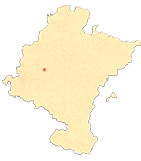La Portada de San Miguel de Estella
Relief of St Michael
To the left of the viewer are two large rectangular slabs with reliefs of marked volumetry. One depicts Saint Michael spearing the dragon, accompanied by an equally winged figure in which a second angel has traditionally been recognised (Marisa Melero suggested seeing the apocalyptic woman). In addition to the serenity of the angelic faces and the richness, perhaps excessive, of the folds of the attire, the large shield of the archangel, bearing an umbo in the manner of a precious stone and reinforced by eight bars radiating in all directions, has attracted attention. It is not surprising that the rich ornamentation of this coat of arms reminded many Navarrese of the emblem of their kingdom, the famous chains, which led some to wonder whether this angelic image might predate the battle of Navas de Tolosa (1212), with whose trophies the origin of Navarre's chains is legendarily linked. However, as Faustino Menéndez Pidal demonstrated, the coat of arms of Navarre was created after 1234, in the time of Theobald I, i.e. several decades after the Estella doorway was carved. We are simply looking at the image of a luxury coat of arms, one of the so-called "blocados", with metallic reinforcement, which were so often represented in the 12th and 13th centuries in different parts of the West.
The second relief represents the weight of souls, an image often used in the Romanesque period to allude to individual post-mortem judgement. The archangel Michael holds the scales in his left hand, which are quite deteriorated. With his right, guide , he points a naked figurine, the soul of a blessed person, towards the seated figure next to him, Abraham, recognisable by the fact that he holds in his bosom little heads corresponding to as many souls of the blessed. This was the abode of the righteous after the death announced in the Gospel parable of the rich man Epulon and the poor man Lazarus. On the other side of the archangel is the deformed presence of the devil. In a lower register, beneath the feet of these three figures, a monstrous head can be seen between whose jaws little heads protrude, while two deformed winged beings are moving towards it, one fanning eternal fire with a bellows and the other dragging the unfortunate ones towards their dreadful destiny.
At summary, the magnificent reliefs condense two of the actions for which Saint Michael, the titular saint of the parish, was venerated: his victory over the infernal dragon and his role as psychopomp, the conductor of souls to heaven.











